The Medical and Scientific Conceptions of Influenza
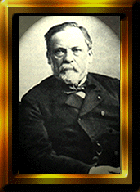
Scientific ideas about influenza, the disease and its origins, shaped the public health and medical responses. In 1918 infectious diseases were beginning to be unraveled. Pasteur and Koch had solidified the germ theory of disease through clear experiments clever science. The bacillus responsible for many infections such as tuberculosis and anthrax had been visualized, isolated and identified. Koch's postulates had been developed to clearly link a disease to a specific microbial agent. The petri dish was widely used to grow sterile cultures of bacteria and investigate bacterial flora. Vaccines had been created for bacterial infections and even the unseen rabies virus by serial passage techniques. The immune system was explained by Paul Erhlich and his side-chain theory. Tests of antibodies such as Wasserman and coagulation experiments were becoming commonplace. Science and medicine were on their way to their complete entanglement and fusion as scientific principles and methodologies made their way into clinical practice, diagnostics and therapy.
The Clinical Descriptions of Influenza

Patients with the influenza disease of the epidemic were generally characterized by common complaints associated with the flu. They had body aches, muscle and joint pain, headache, a sore throat and a unproductive cough with occasionally harsh breathing (JAMA, 1/25/1919). The most common sign of infection was the fever, which ranged from 100 to 104 F and lasted for a few days. The onset of the epidemic influenza was peculiarly sudden, as people were struck down with dizziness, weakness and pain while on duty or in the street (BMJ, 7/13/1918). After the disease was established the mucous membranes became reddened with sneezing. In some cases there was a hemorrhage of the mucous membranes of the nose and bloody noses were commonly seen. Vomiting occurred on occasion, and also sometimes diarrhea but more commonly there was constipation (JAMA, 10/3/1918). A few physicians associated psychoses with influenza infection. One article says that "the frequency of mental disturbances accompanying the acute illness in the epidemic has been the subject of frequent comment," (JAMA, 1/25/1919) The danger of an influenza infection was its tendency to progress into the often fatal secondary bacterial infection of pneumonia. In the patients that did not rapidly recover after three or four days of fever, there is an "irregular pyrexia" due to bronchitis or broncopneumonia (BMJ, 7/13/1918). The pneumonia would often appear after a period of normal temperature with a sharp spike and expectorant of bright red blood. The lobes of the lung became speckled with "pneumonic consolidations." The fatal cases developed toxemia and vasomotor depression (JAMA, 10/3/1918). It was this tendency for secondary complications that made this influenza infection so deadly.
 A military hospital ward in 1918
A military hospital ward in 1918 In the medical literature characterizing the influenza disease, new diagnostic techniques are frequently used to describe the clinical appearance. The most basic clinical guideline was the temperature, a record of which was kept in a table over time. Also closely monitored was the pulse rate. One clinical account said that "the pulse was remarkably slow," (JAMA, 4/12/1919) while others noted that the pulse rate did not increase as expected. With the pulse, the respiration rate was measured and reported to provide clues of the clinical progression. Patients were also occasionally "roentgenographed" or chest x-rayed, (JAMA, 1/25/1919). The discussion of clinical influenza also often included analysis of the blood. The number of white blood cells were counted for many patients. Leukopenia was commonly associated with influenza. The albumin was also measured, since it was noted that transient albuminuria was frequent in influenza patients. This was done by urine analysis. The Wassermann reaction was another added new test of the blood for antibodies (JAMA, 10/3/1918). These new measurements enabled to physicians to have an image of action and knowledge using scientific instruments. They could record precisely the progress of the influenza infection and perhaps were able to forecast its outcome.
 The most novel of these tests were the blood and sputum cultures. Building on the germ theory of disease, the physicians and their associated research scientists attempted to find the culprit for this deadly infection. Physicians would commonly order both blood and sputum cultures of their influenza and pneumonia patients mostly for research and investigative purposes. At the military training camp Camp Lewis during a influenza epidemic, "in all cases of pneumonia...a sputum study, white blood and differential count, blood culture and urine examinations were made as routine," (JAMA, 1/25/1919). The bacterial flora of the nasopharynx of some patients was also cultured since droplet infection was where the disease disseminated. The collected swabs and specimens were inoculated onto blood agar of petri dishes. The grown up bacterial colonies were closely studied to find the causal organism. Commonly found were pneumococcus, streptococcus, staphylococcus and Bacillus influenzae (JAMA, 4/12/1919). These new laboratory tests used in the clinical setting brought in a solid scientific, biological link to the practice of medicine. Medicine had become fully scientific and technologic in its understanding and characterization of the influenza epidemic.
The most novel of these tests were the blood and sputum cultures. Building on the germ theory of disease, the physicians and their associated research scientists attempted to find the culprit for this deadly infection. Physicians would commonly order both blood and sputum cultures of their influenza and pneumonia patients mostly for research and investigative purposes. At the military training camp Camp Lewis during a influenza epidemic, "in all cases of pneumonia...a sputum study, white blood and differential count, blood culture and urine examinations were made as routine," (JAMA, 1/25/1919). The bacterial flora of the nasopharynx of some patients was also cultured since droplet infection was where the disease disseminated. The collected swabs and specimens were inoculated onto blood agar of petri dishes. The grown up bacterial colonies were closely studied to find the causal organism. Commonly found were pneumococcus, streptococcus, staphylococcus and Bacillus influenzae (JAMA, 4/12/1919). These new laboratory tests used in the clinical setting brought in a solid scientific, biological link to the practice of medicine. Medicine had become fully scientific and technologic in its understanding and characterization of the influenza epidemic. Treatment and Therapy
The therapeutic remedies for influenza patients varied from the newly developed drugs to oils and herbs. The therapy was much less scientific than the diagnostics , as the drugs had no clear explanatory theory of action. The treatment was largely symptomatic, aiming to reduce fever or pain. Aspirin, or acetylsalicylic acid was a common remedy. For secondary pneumonia doses of epinephrin were given. To combat the cyanosis physicians gave oxygen by mask or some injected it under the skin (JAMA, 10/3/1918). Others used salicin which reduced pain, discomfort and fever and claimed to reduce the infectivity of the patient. Another popular remedy was cinnamon in powder or oil form with milk to reduce temperature (BMJ, 10/19/1918). Finally, salt of quinine was suggested as a treatment. Most physicians agreed that the patient should be kept in bed (BMJ, 7/13/1918). With that was the advice of plenty of fluids and nourishment. The application of cold to the head, with warm packs or warm drinks was also advised. Warm baths were used as a hydrotherapeutic method in hospitals but were discarded for lack of success (JAMA, 10/3/1918). These treatments, like the suggested prophylactic measures of the public health officials, seemed to originate in the common social practices and not in the growing field of scientific medicine. It seems that as science was entering the medical field, it served only for explanatory, diagnostic and preventative measures such as vaccines and technical tests. This science had little use once a person was ill.
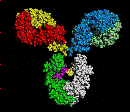
However, a few proposed treatment did incorporate scientific ideas of germ theory and the immune system. O'Malley and Hartman suggested to treat influenza patients with the serum of convalescent patients. They utilize the theorized antibodies to boost the immune system of sick patients. Other treatments were "digitalis," the administration of isotonic glucose and sodium bicarbonate intravenously which was done in military camps (JAMA, 1/4/1919). Ross and Hund too utilized ideas about the immune system and properties of the blood to neutralize toxins and circulate white blood cells. They believed that the best treatment for influenza should aim to: "...neutralize or render the intoxicant inert...and prevent the blood destruction wit its destructive leukopenia and lessened coagulability," (JAMA, 3/1/1919). They tried to create a therapeutic immune serum to fight infection. These therapies built on current scientific ideas and represented the highest biomedical, technological treatment like the antitoxin to diphtheria.
The Etiology of Influenza in 1918
During the 1890 influenza epidemic, Pfeiffer found what he determined to be the microbial agent to cause influenza. In the sputum and respiratory tract of influenza patients in 1892, he isolated the bacteria Bacillus influenzae , which was accepted as the true "virus" though it was not found in localized outbreaks (BMJ, 11/2/1918). However, in studies of the 1907-8 epidemic in the US, Lord had found the bacillus in only 3 of 20 cases. He also found the bacillus in 30% of cultures of sputum from TB patients. Rosenthal further refuted the finding when he found the bacillus in 1 of 6 healthy people in 1900 (JAMA, 1/18/1919). The bacillus was also found to be present in all cases of whooping cough and many cases of measles, chronic bronchitis and scarlet fever (JAMA, 10/5/1918). The influenza pandemic provided scientists the opportunity to confirm or refute this contested microbe as the cause of influenza. The sputum studies from the Camp Lewis epidemic found only a few influenza cases harvesting the influenza bacilli and mostly type IV pneumococcus . They concluded that "the recent epidemic at Camp Lewis was an acute respiratory infection and not an epidemic due to Bacillus influenzae ," (JAMA, 1/25/1919). This finding along with others suggested to most scientists that the Pfeiffer's Bacillus was not the cause of influenza.
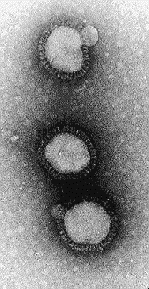
In the 1918-19 influenza pandemic, there was a great drive to find the etiological agent responsible for the deadly scourge. Scientists in their labs were working hard, using the cultures obtained from physician clinics, to isolate the etiological agent for influenza. As a report early in the epidemic said, "the 'influence' of influenza is still veiled in mystery, " (JAMA, 10/5/1918). The nominated bacillus influenzae bacteria seemed to be incorrect and scientists scrambled to isolate the true cause. In the journals, many authors speculated on the type of agent-- was it a new microbe, was it a bacteria, was it a virus? One journal offered that "the severity of the present pandemic, the suddenness of onset...led to the suggestion that the disease cannot be influenza but some other and more lethal infection," (BMJ, 11/2/1918). However, most accepted that the epidemic disease was influenza based on the familiar symptoms and known pattern of disease. The respiratory disease of influenza was understood to give warning in the late spring of its potential effects upon its recrudescence once the weather turned cold in the winter (BMJ, 10/19/1918). One article with foresight stated that "there can be no question that the virus of influenza is a living organism...it is possibly beyond the range of microscopic vision," (BMJ, 11/16/1918). Another article confirmed the idea of an "undiscovered virus" and noted that pneumococccci and streptococci were responsible for "the gravity of the secondary pulmonary complications," (BMJ, 11/2/1918). The article went on to offer the idea of a symbiosis of virus and secondary bacterial infection combining to make it such a severe disease.
The investigators as they attempted to find the responsible agent for the influenza pandemic were developing ideas of infectious microbes and the concept of the virus. The idea of the virus as an infectious agent had been around for years. The articles of the period refer to the "virus" in their discussion but do not consistently use it to be an infectious microbe, distinctive from bacteria. The term virus has the same usage and application as bacillus. In 1918, a virus was defined scientifically to be a submicroscopic infectious entity which could be filtered but not grown in vitro . In the 1880s Pasteur developed an attenuated vaccine for the rabies virus by serial passage way ahead of his time. Ivanoski's work on the tobacco mosaic virus in 1890s lead to the discovery of the virus. He found an infectious agent that acted as a micro organism as it multiplied yet which passed through the sterilizing filter as a nonmicrobe. By the 1910s several viruses, defined as filterable infectious microbes, had been identified as causing infectious disease (Hughes). However, the scientists were still conceptually behind in defining a virus; they distinguished it only by size from a bacteria and not as an obligate parasite with a distinct life cycle dependent on infecting a host cell.

The influenza epidemic afforded the opportunity to research the etiological agent and develop the idea of the virus. Experiments by Nicolle and Le Bailly in Paris were the earliest suggestions that influenza was caused by a "filter-passing virus," (BMJ, 11/2/1918). They filtered out the bacteria from bronchial expectoration of an influenza patient and injected the filtrate into the eyes and nose of two monkeys. The monkeys developed a fever and a marked depression. The filtration was later administered to a volunteer subcutaneously who developed typical signs of influenza. They reasoned that the inoculated person developed influenza from the filtrate since no one else in their quarters developed influenza (JAMA, 12/28/1918). These scientists followed Koch's postulates as they isolated the causal agent from patients with the illness and used it to reproduce the same illness in animals. Through these studies, the scientists proved that influenza was due to a submicroscopic infectious agent and not a bacteria, refuting the claims of Pfeiffer and advancing virology. They were on their way to discerning the virus and characterizing the orthomyxo viruses that lead to the disease of influenza.

These scientific experiments which unravel the cause of influenza, had immediate preventative applications. They would assist in the effort to create a effective vaccine to prevent influenza. This was the ultimate goal of most studies, since vaccines were thought to be the best preventative solution in the early 20th century. Several experiments attempted to produce vaccines, each with a different understanding of the etiology of fatal influenza infection. A Dr. Rosenow invented a vaccine to target the multiple bacterial agents involved from the serum of patients. He aimed to raise the immunity to against the bacteria, the "common causes of death," and not the cause of the initial symptoms by inoculating with the proportions found in the lungs and sputum (JAMA, 1/4/1919). The vaccines made for the British forces took a similar approach and were "mixed vaccines" of pneumococcus and lethal streptococcus. The vaccine development therefore focused on the culture results of what could be isolated from the sickest patients and lagged behind the scientific progress.







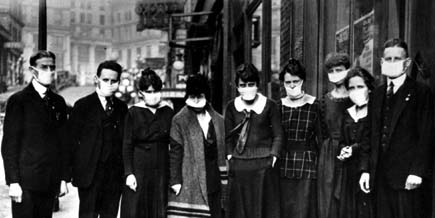







 The Great War, with its mass movements of men in armies and aboard ships, probably aided in its rapid diffusion and attack. The origins of the deadly flu disease were unknown but widely speculated upon. Some of the allies thought of the epidemic as a biological warfare tool of the Germans. Many thought it was a result of the trench warfare, the use of mustard gases and the generated "smoke and fumes" of the war. A national campaign began using the ready rhetoric of war to fight the new enemy of microscopic proportions. A study attempted to reason why the disease had been so devastating in certain localized regions, looking at the climate, the weather and the racial composition of cities. They found humidity to be linked with more severe epidemics as it "fosters the dissemination of the bacteria," (Committee on Atmosphere and Man, 1923). Meanwhile the
The Great War, with its mass movements of men in armies and aboard ships, probably aided in its rapid diffusion and attack. The origins of the deadly flu disease were unknown but widely speculated upon. Some of the allies thought of the epidemic as a biological warfare tool of the Germans. Many thought it was a result of the trench warfare, the use of mustard gases and the generated "smoke and fumes" of the war. A national campaign began using the ready rhetoric of war to fight the new enemy of microscopic proportions. A study attempted to reason why the disease had been so devastating in certain localized regions, looking at the climate, the weather and the racial composition of cities. They found humidity to be linked with more severe epidemics as it "fosters the dissemination of the bacteria," (Committee on Atmosphere and Man, 1923). Meanwhile the 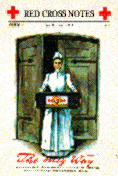


Leave a comment: